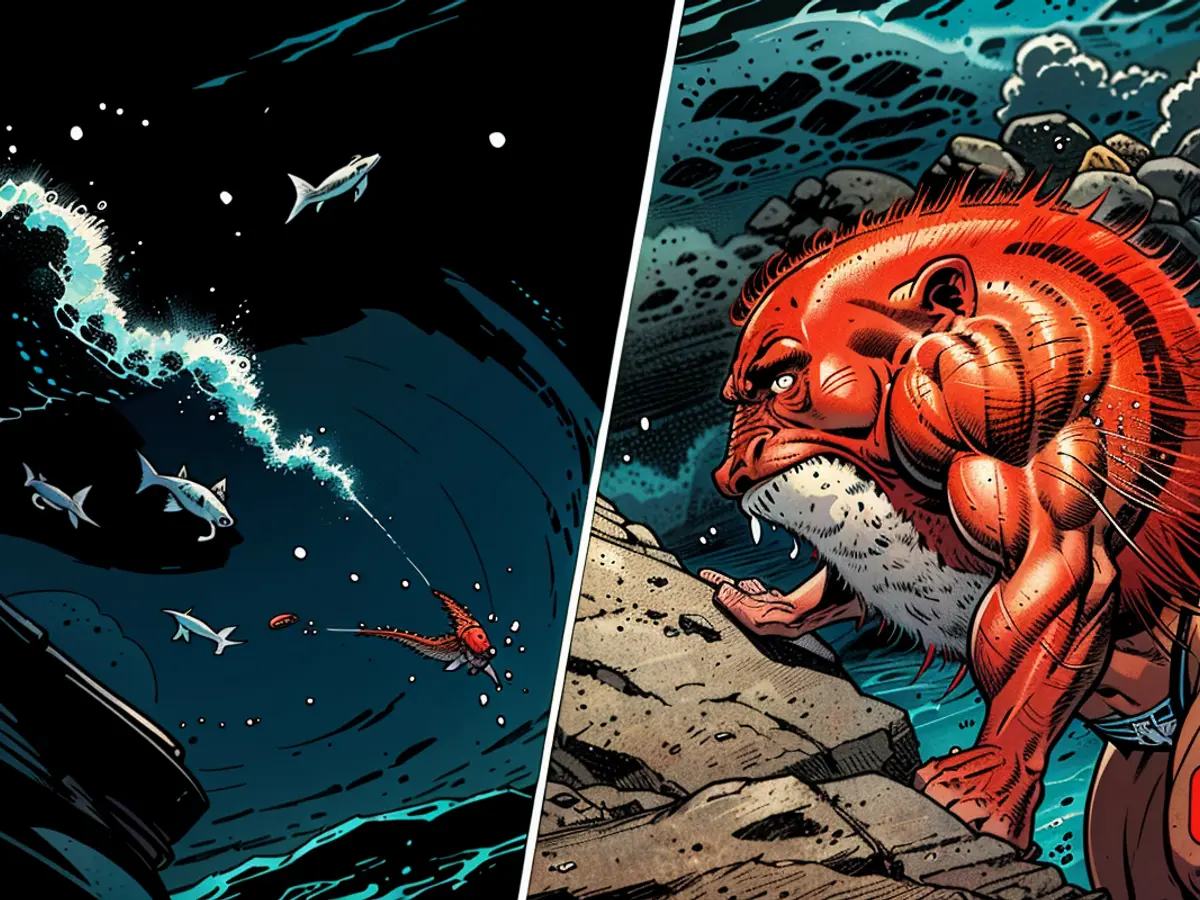- A mechanized diving explorer captures captivating images of enigmatic deep-sea organisms yet to be identified.
Our world harbors a plethora of life forms that humans have yet to witness, their existence merely a figment of our wildest thoughts. According to researchers, approximately several million animal, plant, fungal, and microbial species remain undiscovered, undescribed, and uncatalogued. Many of these so-called "hidden taxa" flourish in places humans seldom tread upon: in the soil or the depths of the ocean, hundreds of meters beneath the surface.
It's in these depths where scientists claim to have found over a hundred new species: deep-sea corals and sea urchins, lobsters and glass sponges, amphipods and fish. They are adorned with numerous tiny arms, stiff limbs, or sharp spines, and some appear so odd that they could be creations of an overactive imagination. However, the clear photos and videos captured by a submerged robotleave no room for doubt about their existence.
These discoveries were made by an international research team led by marine biologist Javier Sellanes during an expedition sponsored by the Schmidt Ocean Institute in the southeastern Pacific off the coast of Chile. During this expedition, the scientists scanned 52,777 square kilometers of seabed between January 8 and February 11, exploring several underwater mountains, or seamounts, in the process.

The region is home to numerous such seamounts. Spanning an area of 2,900 square kilometers at a right angle to the South American coast are the Nazca and Salas y Gómez mountain ranges: an underwater mountain range formed by volcanic activity, boasting over 200 peaks, extending from the Chilean coast to Easter Island (Rapa Nui). Unfortunately, only a few of these peaks have been explored.
At times, we're unaware of their existence. The researchers discovered several previously undetected underwater mountains. The tallest of them – informally named Solito, the Loner – stands at an impressive 3,530 meters high, surpassing the Zugspitze by over 500 meters.

Biodiversity hotspots: Each mountain harbors a unique ecosystem
The mountainous peaks in the deep sea serve as biodiversity hotspots: Seamounts influence ocean current patterns and offer protection, food, and a surface for deep-sea creatures to cling onto. Because the region is isolated from the rest of the ocean by the Atacama Trench, the Humboldt Current, and an extensive oxygen minimum zone, about half of the species living here are found nowhere else on Earth.

To uncover which hidden marine residents inhabit these mountains and to obtain a comprehensive understanding of species diversity, researchers utilized echo sounders, sensors, and cameras to delve into the water. The "ROV SuBastian" submerged diving robot scaled the slopes of ten mountains from top to bottom, reaching depths of up to 4,500 meters.
The images it sent back surpassed the researchers' wildest expectations: Each underwater mountain houses its own distinct ecosystem, surrounded by thriving deep-sea coral reefs or sponge gardens, and inhabited by unknown crabs and sea urchins. The researchers identified over 100 potential new species. Currently, they are analyzing their physiology and genetics to determine if they are indeed entirely new species. Given the vast number, this could take several years.
![This crustacean resides in a coral sanctuary, situated at a depth of 2,200 feet [669 m] beneath an underwater mountain's incline. This crustacean resides within a coral at a depth of 669 meters on the incline of an underwater mountain.](https://cdn.aussiedlerbote.de/content/images/2024/08/29/466715/jpeg/4-3/1200/75/this-lobster-lives-in-a-coral-reef-at-2200-feet-669-m-below-the-slope-of-an-underwater-mountain.webp)
"This expedition has exceeded our expectations. We always hope to discover new species in these remote and scarcely explored areas, but the number we've found, particularly among some groups like the swarms, is astonishing," stated Javier Sellanes in a statement from the private marine research institute.
Data could aide in establishing a protected area

The dive not only produced captivating images but also has the potential to safeguard the sea. Chile is planning to create a protected area along the Nazca and Salas y Gómez ridges; however, most of the mountain range lies outside Chile's territorial waters in international waters. The new data could contribute to designating the area as an international marine protected area – as many of the species inhabit fragile habitats under threat from deep-sea mining and trawl fishing.
The health of the newly discovered species in existing protected areas, such as the Juan Fernández and Nazca-Desventuradas marine parks, is evident from neighboring observations. "These thriving and healthy ecosystems demonstrate that the Nazca-Desventuradas and Juan Fernández marine parks efficiently protect sensitive marine environments," noted Sellanes.

The fate of the yet-to-be-discovered creatures at the edges of the unexplored underwater mountains remains largely unknown. But the research vessel "Falkor" is scheduled to set sail once again tomorrow to explore the Salas y Gómez ridge in a second expedition. The dives can be viewed live on the YouTube page of the Schmidt Ocean Institute.
The institute, funded by US billionaire Eric Schmidt and regularly dispatching research ships equipped with advanced technology on exploration missions, is part of a larger initiative aiming to discover 100,000 new ocean species in the coming years. Therefore, the deep-sea corals, bony fish, and lobsters are far from the only hidden deep-sea dwellers we can anticipate encountering in the future.
The deep-sea corals and sea urchins discovered in the depths are just a few examples of the numerous new species found in these underwater biodiversity hotspots. The sea around the Nazca and Salas y Gómez mountain ranges, with its unique ecosystems and isolated habitats, is teeming with undiscovered marine life.







